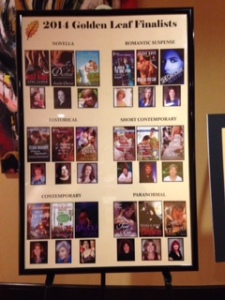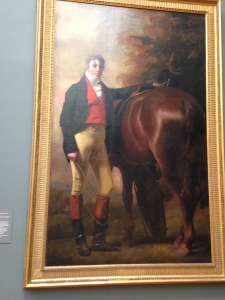This weekend I attended the New Jersey Romance Writers Put Your Heart In A Book annual conference. My A Marriage of Notoriety was a finalist for their Golden Leaf contest. Alas, it did not win. That honor went to Caroline Linden for Love and Other Scandals.

But it was a great consolation to me that I had two of the Risky Regencies at my side to console me. Elena and Gail and I got to spend a little bit of time together and that was really wonderful. Here’s our selfie as proof:

On Sunday after the conference I went into the City (New York City, of course) to the Metropolitan Museum of Art and gazed upon some familiar and loved paintings of “our” era (well, a little before our era), like this 1790 Thomas Lawrence of Elizabeth Farren, the Irish actress who later became the Countess of Derby.

But I also saw some new-to-me portraits.
Sir Joshua Reynolds’ portrait (1766) of The Honorable Henry Fane, Inigo Jones, and Charles Blair.

The Inigo Jones of this portrait (left) is a descendent and namesake of the celebrated architect of the same name.
Henry Fane (center) (1739-1802) was the second son of the 8th Earl of Westmorland and was once describes as “very idle and careless and spending much timie in the country”–with friends like Charles and Inigo, I wonder? He became a MP for Lyme Regis, the family’s rotten borough. He married the daughter of a banker and had 14 children!
Charles Blair (right) is Fane’s brother-in-law, about whom there is nothing in Wikipedia (even I appear in Wikipedia). To me, he is the most prominent figure in the portrait.
Another portrait I’d not seen before was this Henry Raeburn portrait of George Harley Drummond.

Drummond’s life reads like a character from a Regency novel…and I don’t mean the hero! He was born into a banking family but was orphaned at the age of five and brought up by relatives. His father was a terrible spendthrift and gambler and left his son with huge debts, but those banking relatives managed to build up the fortune again by the time Drummond reached his majority. He turned out, though, to be just as reckless as his father. The relatives, recognizing this, did not let him become a partner in the bank, although he received an income from it. He made a hasty marriage, built a castle he couldn’t afford, and became an MP for two terms. In 1820 his debts caught up with him. (He was said to have lost £20,000 to Beau Brummmell in one session at White’s). He deserted his wife and ran off with the wife of a Navy captain. Ultimately he fled his creditors and escaped to Ireland where he lived the rest of his life.
This painting, though, was more renowned because of its depiction of the grazing horse. To paint the horse in this position was a very difficult endeavor. No one knows why Raeburn painted the horse with its hindquarters so prominent, but I think the artist might have been trying to say that the subject of the portrait was a horse’s ass.
The painting does show a gentleman’s clothes in great detail, though.
All in all I had a wonderful weekend! Risky Regencies, fellow writers, famous paintings and a horse’s ass!
How was your weekend?

It was great hanging out with you and Gail! And thanks for sharing those pictures. It’s been a really long time since I’ve been to that museum. If I go to RWA, maybe I’ll make some time for a side excursion.
I’ll go with you! Last time in NYC, I didn’t do anything outside of the conference and later I regretted it.
What a lovely weekend you had! It rained here, and I visited with friends. Can’t complain.
You’re right about the artist. They’re notorious for their layered meanings. My sister used to work in an art department. After studying art history, she informed me, “Never, never annoy an artist. They will find a way to unfavorably immortalize you in a way that lasts through the ages.”
Oh, I love that, Laurel. Now I really do believe the artist was calling his subject a horse’s ass!
Lucky you to go to the museum. I like your backside of the horse deduction. It could have been the artist’s statement or Drummond’s comment to his peers.
I am not sure if this is the same Charles Blair, but this was on selectsurnames2.com:
Among the 18th century arrivals were …..and Charles Blair of Winterbourne in Dorset, a man who had made money and married well (his descendant was the more down-at-heel Eric Blair, better known by his pen-name George Orwell).
He is listed as one of Fane’s guardians on one site.
[…] already talked about the New Jersey Romance Writers conference, where she, Gail and I were fortunate enough to hang out together and celebrate Diane’s […]
Good detective work, LibraryPat!! Blair’s prominence and color in the painting made me think he was the solvent one who paid for it, and that his friends were included at his behest –speaking of visual clues left by artists!! The picture can almost be split into two.
I had a great time with Diane and Elena in NJ, and am considering RWA in NYC next summer. A trip to the museum is a must-do side-trip if I do go!